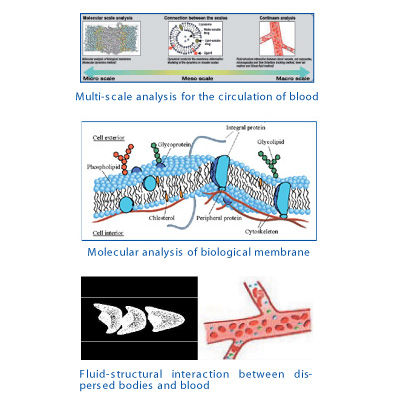 |
 |
|
|||||||||||||||||||||||||
|
| Hyper modeling and simulation for future biomedical innovation -From molecular analysis of biomedical membrane to biofluidics- |
| Analysis of Microcirculation System of Blood |
 Yoichiro Matsumoto, Professor Yoichiro Matsumoto, ProfessorDepartment of Mechanical Engineering The development of simulation tools for the circulation of blood in the human body is getting more important for the achievement of advanced medical care for cardiovascular diease, cerebrovascular disease, and others, which are becoming increasingly serious problems in the aging society. Especially, the blood flow in capillary vessels plays an important role for many kinds of molecular transfer to/from the surrounding cells. In these flows, the mechanical properties of dispersed bodies such as red blood cells and mass transfer in molecular level are closely related each other. To evaluate the effect of these factors quantitatively and to control them effectively, development of the simulation tool, which can handle the multi-scale physics from the molecular scale to continuum scale, is required. In the present study, we are developing the simulation tool to analyze these kinds of complicated microcirculation systems rationally and accurately. |
 |
| Micro Cell Processing |
 Nobuhide Kasagi, Professor Nobuhide Kasagi, ProfessorDepartment of Mechanical Engineering Regenerative medicine is a promising future biomedical technology, in which multipotent stem cells are cultured to proliferate indefinitely or differentiate into various tissues and transplanted to damaged or deficit tissues and/or organs. Currently, the design methodology as well as prototype development of a miniaturized cell sorting system are being studied with micro fluidic components integrated on a single chip of several square centimeters in order to achieve minimized sample size, fast processing and lower cost. Specifically, a micro chaotic mixer has been developed, utilizing magnetic force as external perturbations to induce Lagrangian chaos. Numerical simulation of microscale multiphase fluid flow, including motion of cells with deformation, antigen/antibody reactions at the cell membrane, and magnetic-bead motion under a time-varying magnetic field will lead to a highly integrated design and analysis tool for physical phenomena related to biofluidic processing. |
 |
Page top |